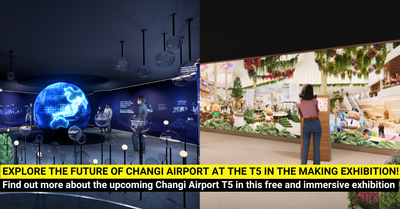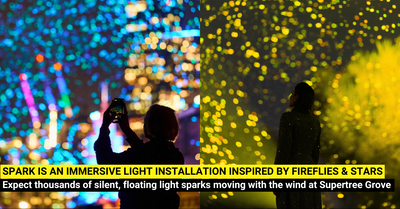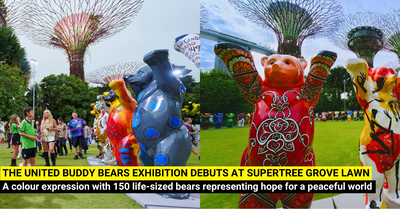The exhibition brings a unique curatorial approach that uncovers a fresh perspective of understanding different forms of art.
Venue: Dalam Southeast Asia, UOB Southeast Asia Gallery, National Gallery Singapore
Date: 5 Apr to 1 Dec 2024
Fee: Free for Singaporeans & Permanent Residents
Figuring a Scene

How do you understand and make sense of artworks? Dr. Patrick Flores, Deputy Director of Curatorial and Research at National Gallery Singapore suggests that elements from nature can lend meaning by animating social forms and shaping each viewer’s unique understanding of artworks. This inquiry is explored in National Gallery Singapore’s upcoming exhibition, Figuring a Scene, which opens from 5 April to 1 December 2024.
Housed in Dalam Southeast Asia – the Gallery’s first-ever experimental project space advocating for the lesser-known narratives and the recalibration of the typical collections-based long-term display – Dr. Flores presents artworks in six episodes, trying out a curatorial approach that departs from the loose chronological order of the UOB Southeast Asia Gallery.
Each section is based on a natural element perceived in the artwork, inviting visitors to consider how elements of nature can draw out different interpretations based on each individual’s situation, knowledge and lived experiences. These elements are commonplace, and usually taken for granted, resulting in the need for them to be re-experienced in the context of an exhibition and the life of art forms. The episodes can be viewed collectively or independently. When viewed collectively, visitors may uncover links between the exhibition materials across the different episodes.
Exhibition Highlights
Episode 1: Shadow

The artist Sharon Chin lives and works in Port Dickson, Malaysia, where she tends to a garden that is visited by stray animals. At her doorstep is an oil refinery that emits a glowing light at night. It is a setting that holds both nature and technology—the various species of the earth and global industry—in tension.
Informed by her commitment to climate justice and the critique of ecological displacement, Chin sensitively probes this tension in her work. This can be seen in the linocut prints of animals she produced for Zedeck Siew’s Creatures of Near Kingdoms, as well as the placards crafted for a climate protest in Kuala Lumpur. The prints and placards in their different iterations were then relocated to a museum setting as part of a mural, before being remade into shadow puppets. These puppets are part of a performance that happens in the liminal site between Chin’s garden and the refinery, staged through the light of “fossil capitalism.” In this installation, forms ominously and urgently emerge from the struggle between natural and social forces, and the artist asks: “Without darkness, how can we dream of the day?”
Episode 2: Fruit
Three works explore the durian, a fruit that has helped to shape the imagination of Singapore and Southeast Asia. A painting, a photograph and a sculpture articulate the image of the durian in different ways. Liu Kang paints the various phases of its passage where the durian—sharing space with the mangosteen—is gathered for the market, pried open, prepared for sale, placed on shoulder pole baskets and then eaten. Then, from the durian tree itself, Anusapati carves out an abstract and minimal sculptural piece reminiscent of the kentongan (a Javanese musical instrument), while also referencing the Romanian artist Constantin Brancusi. Finally, Robert Zhao Renhui photographs a durian tree in the forest of Bukit Panjang, depicting it as a formidable witness to what comes to pass in the environment around it, and which a forager considers to bear the sweetest fruit.
The durian assumes different guises in history and everyday life. In this transformation, we discover how it became culturally meaningful: both within the necessary desire for a sense of place and belonging, as well as the memories of the land, its ancestors and its colonisers.
Episode 3: Fire
In 1961, a tragic fire engulfed villages and communities in Bukit Ho Swee. It was a critical moment in the social history of Malaya. Characterised as a sprawling, congested and “inert” slum of attap huts, Bukit Ho Swee was home to around 16,000 people. To a significant extent, the fire helped to pave the way for the country’s urban transformation. An important aspect of this modernisation was the intense pace of the construction of public housing itself. Artists like Liu Kang, Lim Hak Tai, Tan Choo Kuan and Lim Yew Kuan have referenced various fiery incidents in Malaya and independent Singapore in their works, depicting them as both ruinous and generative in post-colonial times. These artists portrayed the ferocity of the element itself, as well as its aftermath as people tried to rebuild. Thus, the themes of nostalgia, the anticipation of a new beginning and a portrayal of everyday life are all present in their works.
In particular, the way everyday life is depicted stands in contrast to the predominantly exotic or pastoral scenes that the Nanyang artists and the Ten Men Group were known for. For Singapore, the Bukit Ho Swee fire was a turning point, one that pointed towards the possibility of the modern, while the reconstruction that followed would soon become a central trope in its narrative.
Episode 4: Air

Representing air in art is a challenge because we cannot see it, yet air is omnipresent and vital. The artist Sun Yee conjures air through a rendering of wind causing trees to sway. With brushstrokes, she also implies the trickle of rain through streaks of white paint that slightly and intermittently speckle parts of the trees. This is an indication of a possible storm, an impression that is enhanced by the oblique orientation of the painting. In Lim Tzay Chuen’s photograph, we see the cloud of vapour from a fogger that releases pheromones—chemicals that an organism secretes to induce physical attraction. The image is a reference to the artist’s performance at the first Singapore Biennale in 2006 at the historic City Hall building, which is now part of National Gallery Singapore. Like the flecks of white paint delicately applied onto the canvas by Sun, the particles of a diffused atmosphere are faintly visible. Slowly, with the light that sculpts the contours of the stairs of the storied building, these particles eventually acquire their own presence.
Episode 5: Wax

Photo Credits: National Gallery Singapore
The title of Renato Habulan’s assemblage, Tira, is a Filipino word that carries many different meanings: it could mean “remnants,” the action of striking or could even be the root word for “residence.” The work is made of many components, including driftwood and found figurines. However, the most intriguing part of the work is the paraffin wax in which various items are embedded or on which they rest, such as a wooden sculpture of a transfigured Christ which was found in a carving workshop, incomplete and unconsecrated. The scene depicted in the work is a reference to Catholicism, the colonial religion in the Philippines. Over time, this spiritual system has been reshaped by folk and popular reinterpretation, gaining diverse post-colonial meanings and political effects. It thus reflects the system’s widespread influence as well as its fragmentation, heightening the horrors of war in southern Philippines. Amid this seeming dispersal of persistent forms, the artist proposes a kind of synthesis, revealing a haunting ecology of images alongside organic materials like driftwood and wax. The tableau is part-altar, part-processional carriage and part-sepulcher.
Episode 6: City
Public housing and the art museum are two signs of Singapore’s aspiration to a national and modern form. These two impulses can be traced to discourses emerging from post-colonial Malaya. These discourses may be observed through architectural and engineering texts, which are situated within the encompassing project of modernist nation-building and the policy of socialised human settlement. One text written a year after Singapore gained independence claims that the cultural role of Singapore as a city was “so vital in the creation of national identity.” Another text details the process of constructing apartments, including the use of brick, sand and granite by the Housing and Development Board in 1962. The catalyst for this programme was the 1961 Bukit Ho Swee fire, an event which transformed “squatters into citizens” just before Singapore gained independence in 1965. Complicating this yearning for cultural and physical well-being through art and shelter is one of the two teak sculptures by Shui Tit Sing. The seemingly quaint vignette hints at despair amid the thrill of change, or trauma in the wake of tragedy. In the end, the fantasy of development is disrupted by the folklore of residents falling off high-rise buildings. Almost 80% of Singaporeans are currently housed publicly.
Exhibition Programmes
In Dialogue with Patrick Flores and Siddharta Perez
Venue: National Gallery Singapore, Supreme Court Wing, L4 Mezzanine, Glass Room
Date: 11 May 2024
Time: 11 am
Fee: Free, registration required
How do exhibitions define how we make sense of history or society? This conversation between Dr. Patrick Flores and curator Siddharta Perez will delve into debates around exhibition-making and the tension between making and making sense.
For an updated listing of programmes, please visit this link.






![30+ Of The Best Kid-friendly Museums And Exhibition in Singapore For All Ages [2025 UPDATED]](http://www.bykido.com/cdn/shop/articles/c2b80d63041615fedc7f3b0047c2c6b4_520x500_520x500_19113881-0300-4997-840a-e1018c34aa5a_400x.webp?v=1765950472)
